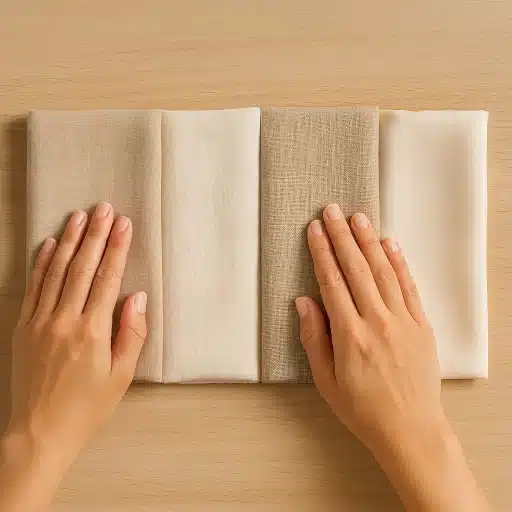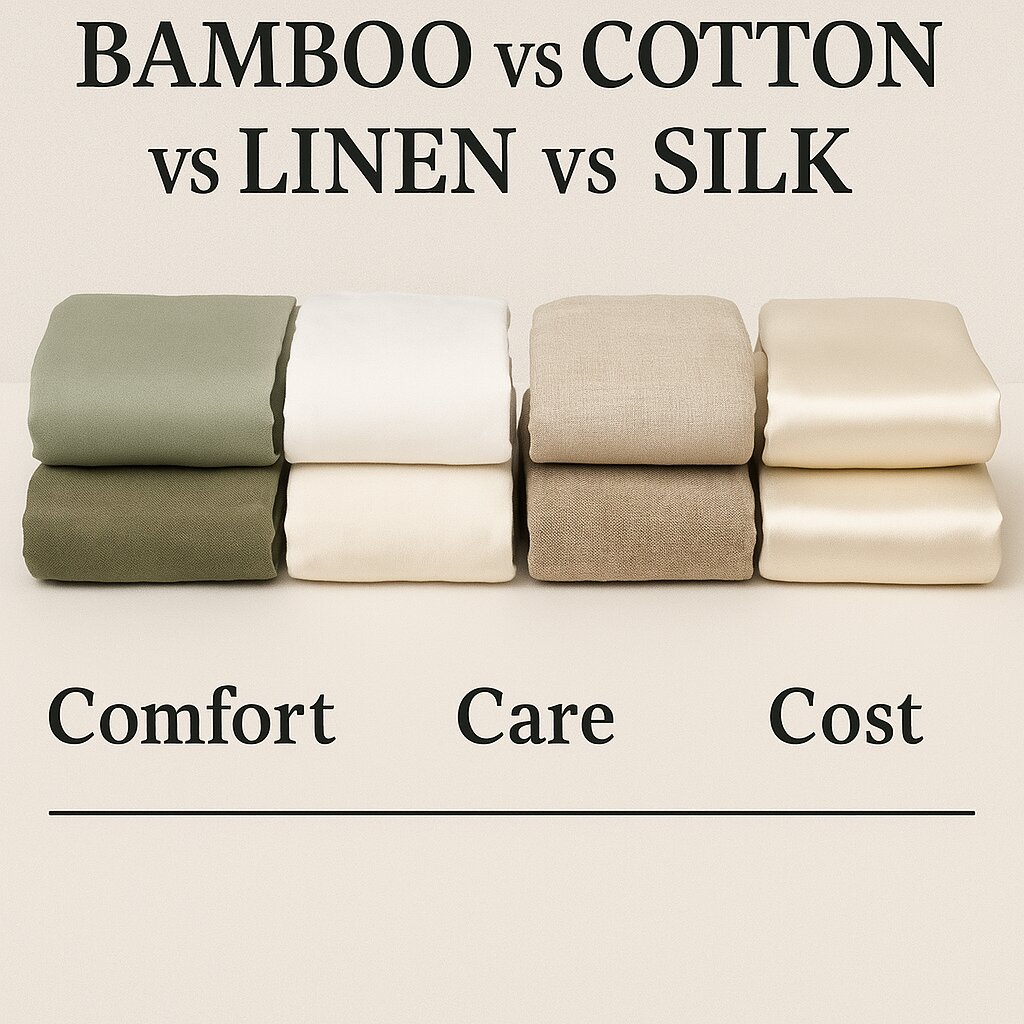Bamboo vs Cotton vs Linen vs Silk—four popular bedding materials, each with their own feel, benefits, and price tag. If you’ve ever spent the night struggling to get comfortable because your sheets felt too hot, too rough, or just not quite right, you know how tricky it can be to find the perfect set.
Here, you’ll find a breakdown of the real-life pros and cons of each fabric, so you can match your bedding to your sleep style, skin needs, and values.
What’s Inside This Post
Bamboo Sheets – Soft, Cool, and Eco-Friendly
Do you ever wake up sweaty? Bamboo might be just the thing to help you sleep cooler. It’s soft and smooth, kind of like a mix between cotton and silk, but without that slippery feeling.
What makes bamboo stand out is its breathability. The natural micro-gaps in the fibers let air move through easily, helping to wick away moisture. That’s a big plus for hot sleepers.
Bamboo is also considered eco-friendly, especially when it’s made using the lyocell process. This method uses less water and recycles most of the chemicals, making it a smarter choice for the planet.
A few things to know:
- Bamboo needs gentle care.
- Cold wash, low heat dry.
- Skip fabric softeners to keep it feeling fresh.
Cotton Sheets – Familiar, Affordable, and Easy to Care For
Cotton is the most common bedding material, and for good reason. It’s soft, breathable, and super easy to care for. You can toss it in the washer and dryer without much thought.
The feel can vary a lot. Some cotton sheets are light and crisp, while others are heavier and warmer. The quality depends on the type of cotton and the weave.
If you’re watching your budget, cotton is usually the most affordable. Just keep in mind, conventional cotton uses a lot of water and pesticides. If that’s something you care about, organic cotton is the better pick.
A few things to know:
- Machine wash is easy—use warm or cool water.
- Tumble dry on medium or low heat.
- Percale feels crisper, sateen feels smoother.
- Organic cotton is the better choice if you care about the environment.
Linen Sheets – Breathable, Strong, and Long-Lasting
Linen feels a bit different from the others. It starts out crisp and slightly rough, but don’t let that scare you off. The more you wash and use it, the softer it gets.
What makes linen a favorite for many is how cool and breathable it feels. It’s perfect for warm climates or anyone who tends to overheat at night.
Linen is also incredibly durable—we’re talking decades if you take care of it. But it does wrinkle easily, so if you like a perfectly smooth bed, it might not be your thing.
Care tip: Gentle wash, air dry if you can. Expect wrinkles—that’s part of its charm.
A few things to know:
- Starts out crisp, but softens with every wash.
- Air drying helps reduce wrinkles.
- Wrinkles are part of its natural look—don’t expect a hotel-smooth finish.
- Lasts for years, even decades, if cared for properly.
Silk Sheets – Smooth, Luxurious, and Delicate
If you’re after luxury, silk is hard to beat. It feels soft, smooth, and cool when you first slip into bed. Silk is also great for your skin and hair because it doesn’t tug or cause frizz.
But silk is high-maintenance. It’s very delicate, and you’ll need to hand wash or dry clean most silk sheets to keep them looking good.
Also, while silk starts off cool, it tends to trap heat as you sleep, which might not work for hot sleepers.
And yes—it’s the priciest option on this list.
A few things to know:
- Silk needs gentle care—hand wash or dry clean only.
- Avoid wringing or twisting to prevent damage.
- Air dry away from direct sunlight.
- Feels smooth and cool at first but may trap heat overnight.
- Expect to pay more for high-quality silk.
What It’s Like to Sleep On Each Fabric
Bamboo
Soft, light, and silky. Bamboo sheets have a smooth, cool touch that feels great on your skin, especially if you have allergies or sensitivity to rough fabrics. They drape nicely over your body and stay fresh longer between washes.
Cotton
Familiar and cozy. Cotton sheets feel crisp when they’re new, especially if you choose percale. Sateen cotton feels smoother and slightly warmer. They soften up over time and hold up well to frequent washing.
Linen
Textured but breathable. Linen sheets start off a bit rough but soften the more you use and wash them. They feel dry and airy, never sticky or heavy. Perfect if you like that casual, lived-in look.
Silk
Smooth and cool at first, but cozy as you settle in. Silk sheets glide over your skin and help reduce friction, which is great for hair and skin. They feel luxurious, but they can trap a bit of warmth overnight.
If you’ve ever wondered how bamboo vs cotton vs linen vs silk sheets really compare, the truth is—each one feels completely different when you actually sleep on them. From the crispness of linen to the smooth luxury of silk, the right choice comes down to how you like your bed to feel night after night.
Quick Comparison Table
| Feature | Bamboo | Cotton | Linen | Silk |
|---|---|---|---|---|
| Softness/Feel | Silky, smooth | Varies (crisp to soft) | Crisp, textured | Ultra-smooth, luxe |
| Breathability | Excellent – great for hot sleepers | Good (varies by weave and quality) | Excellent – naturally cool and airy | Good – but can trap warmth |
| Sustainability | High (best if made with lyocell process) | Moderate (best if organic cotton) | Very high – requires little water/chemicals | Low to moderate – labor-intensive production |
| Durability | Good – lasts for years with proper care | Good – but may wear faster with frequent use | Excellent – can last decades if well cared for | Fair – delicate and prone to damage |
| Care | Gentle wash, low heat drying recommended | Easy – machine wash and dry | Gentle wash, expect wrinkles, air dry best | Very delicate – hand wash or dry clean only |
| Price | $$–$$$ | $–$$$ | $$$ | $$$$ |
| Best For | Hot sleepers, sensitive skin, eco-conscious | Everyday use, budget shoppers | Longevity, natural texture lovers | Luxury seekers, skin/hair care |

Pros and Cons of Each Fabric
Bamboo Sheets
- Pros: Soft, breathable, great for sensitive skin, eco-friendly (if lyocell)
- Cons: Wrinkles easily, needs gentle care, can be pricey
Cotton Sheets
- Pros: Affordable, easy to care for, softens with use
- Cons: Not always the softest at first, can trap heat, conventional cotton isn’t very eco-friendly
Linen Sheets
- Pros: Extremely durable, very breathable, eco-friendly, softens over time
- Cons: Wrinkles easily, feels rough at first, higher price point
Silk Sheets
- Cons: Expensive, very delicate, not the most sustainable choice
- Pros: Luxurious feel, smooth on skin and hair, reduces friction
Certifications and Processing Tips
If you’re looking for bedding that’s safe for your skin and better for the planet, watch for these certifications:
- OEKO-TEX® – Certified safe from harmful chemicals and substances.
- GOTS (Global Organic Textile Standard) – The top certification for organic cotton, covering both environmental and social standards.
- Lyocell Process (for Bamboo) – A closed-loop production method that reuses water and reduces chemical waste, making bamboo fabric more eco-friendly – Eco-friendly process that reuses water and chemicals. Look for TENCEL™ Lyocell, a trusted lyocell brand.tencel.com), one of the most trusted and recognized lyocell brands
Not all bamboo sheets are created the same. Look for bamboo lyocell or closed-loop production to be sure you’re getting the eco-friendly kind.
Frequently Asked Questions
- Is bamboo better than cotton for hot sleepers? Yes, bamboo breathes really well and pulls moisture away from your skin. Cotton can work too, especially crisp percale cotton—but not all cotton feels as cool or fresh as bamboo.
- Are silk sheets good for your skin and hair? They sure are. Silk’s smooth surface helps reduce friction on your skin and hair, which might help with sleep wrinkles and hair frizz. Bamboo pillowcases offer similar benefits if you’re looking for a gentler, more affordable option.
- Do linen sheets feel rough? They do at first. Linen starts out a bit coarse, but it softens up with every wash. After a few washes, it feels much more comfortable—many people love how it gets better over time.
- Which sheet fabric is the most eco-friendly? Linen is one of the most eco-friendly options because it uses much less water and fewer chemicals than cotton or silk. Bamboo can also be a great choice, but it depends on how it’s processed—bamboo lyocell is the best option to look for.
- How long do these fabrics usually last? Silk is the most delicate. Cotton and bamboo typically last around 3 to 5 years with regular use. Linen is the most durable—it can last a decade or more if you take care of it.
- Is bamboo fabric good for sensitive skin? Yes, bamboo feels soft and smooth, and it doesn’t trap dust or moisture like some other fabrics. That’s why people with eczema, allergies, or sensitive skin often find bamboo more comfortable than rougher materials like polyester or coarse cotton.
Fabric Care & Lifespan Table
| Fabric | Machine Washable | Dryer Safe | Special Notes | Typical Lifespan |
|---|---|---|---|---|
| Bamboo | Yes, cold cycle | Yes, low heat | Avoid bleach/softeners | 3–5 years |
| Cotton | Yes, any temp | Yes | Gets softer with use | 3–5+ years |
| Linen | Yes, cool wash | Yes, low heat | Wrinkles easily | 10+ years |
| Silk | Gentle cycle or hand wash | Air dry | Snags easily, no bleach | 1–3 years |
Final Thoughts on Bamboo vs Cotton vs Linen vs Silk Sheets
Finding the right sheets isn’t always easy, especially when you’re comparing bamboo vs cotton vs linen vs silk. But knowing how each fabric feels and performs can make that choice a little less overwhelming.
If you tend to wake up hot and sweaty, bamboo or linen could be the cooling relief you’ve been searching for. Want something familiar, easy to care for, and budget-friendly? Cotton still holds its place in many homes. And if you’re chasing that smooth, luxurious feel, silk might just win you over—if you don’t mind the extra care it needs.
If you’re still unsure, I’ve got more detailed comparisons that go deeper into the differences between bamboo and cotton sheets and bamboo and linen sheets. These guides break it down even further to help you figure out what feels right for you, your skin, and your budget.
Whatever you choose, here’s to better sleep and bedding that works for you, not against you.

